Lesson 2: Specialty References – Injectable Drugs, Interactions, and Adverse Effects

Dan is a 64-year-old Asian man who takes 12 different prescription medications for a variety of conditions such as diabetes, heart disease, and lung problems. Lately he has been having pain in his left knee that seems to be related to osteoarthritis. He wonders if it would be safe for him to take Aleve® in addition to all of his other medications.
Where would you go to find an answer to Dan’s question?
Specialty references are able to answer specific questions pertaining to pharmacy and pharmacotherapy.
In this module, we will review specialty references pertaining to:
- Injectable drug compatibility and administration
- Drug interactions (drug-drug, drug-disease, etc)
- Adverse effects
- And many more
Each of these items is described in more detail below. As you review, pay special attention to the special traits that differentiate one resource from another.
Injectable drugs
Handbook on Injectable Drugs (“Trissel’s”)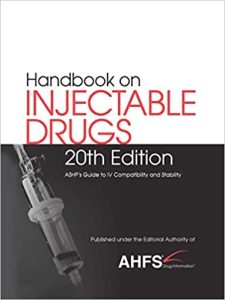
- Published yearly by the American Society of Health-System Pharmacists
- Available online via HSL: “ASHP’s Interactive Handbook on Injectable Drugs”
- Product information
- Sizes, strengths, volumes, and forms in which the drug is supplied
- Instructions for reconstitution
- pH, osmolarity, dilution instructions (when available), sodium content (where applicable)
- Administration
- Routes and rates of administration
- Stability
- Stability and storage requirement
- Effects of pH, freezing, and exposure to light
- Sorption and filtration characteristics
- Compatibility information
- Solution – compatibility of a drug in various infusion solutions
- Additive – compatibility of 2 or more drugs
- Syringe – compatibility of 2 ore more drugs in syringes
- Y-site – compatibility of 2 or more drugs in simulated or actual injection into Y-sites (connecting IV lines)
- Additional information
- Home health compatibility (ie, ambulatory infusion pumps)
- Peritoneal dialysis/drug compatibility
This is THE “go-to” reference for intravenous (IV) medication compatibility
Pediatric Injectable Drugs (“Teddy Bear Book”)
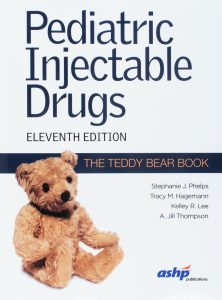 In print and online via HSL
In print and online via HSL- Published by the American Society of Health-System Pharmacists
- Covers age-specific dosing and administration guidelines for neonates through adolescents
- Monograph format
- Dosage adjustment in organ dysfunction, maximum dosage, IV push, intermittent infusion, continuous infusion, IM administration, maximum concentration, cautions related to IV administration
- Parenteral administration of medications specific to pediatric patients
- Medication error potential
- Infusion-related cautions
- Dosage adjustment in organ dysfunction
- Additives
- Maximum concentrations and dosages
- Preparation and delivery
- Suitable diluents
- IV push
- Intermittent infusion
- Continuous infusion
- Other routes of administration
- Appendices
- Nomogram for determining body surface area of children
- Nomogram for estimating ideal body mass in children
- Additives and antibiotic considerations
- Y-site compatibility of medications with parenteral nutrition
- Extravasation treatment
“Go-to” reference for pediatric intravenous questions; however, does not include IV drug-drug compatibility information (Use Trissels for that).
Drug Interactions
Many of our general pharmacy resources incorporate tools to check drug-drug, drug-disease, or drug-allergy interactions.
Facts & Comparisons eAnswers – Interaction Tool
- Published by Facts and Comparisons
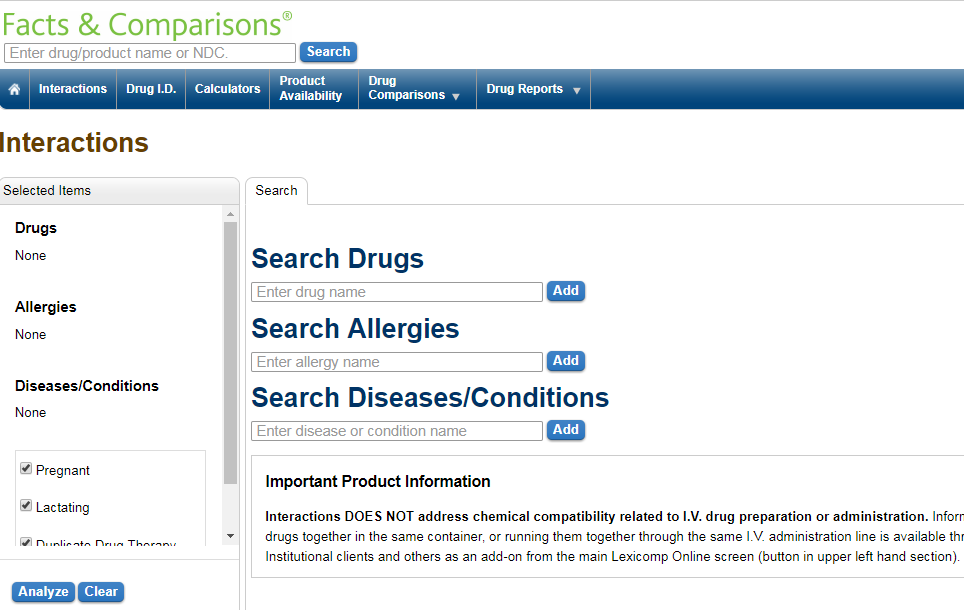
- Available in print and online via F&C
- More than 1,800 drug interaction monographs covering 20,000 drugs
- The interaction tool provides documentation of interactions
- Rated unlikely to established
- Based on quality and clinical relevance of primary literature
- Significance rated 1 through 5 based on severity and documentation
- 1 is severe and well-documented interaction
- 5 is an interaction with no more than unlikely or possible documentation
- Provides guidance on management options
- Online version includes fields for drug allergies, disease/symptoms, pregnant, lactating, duplicate therapy
Micromedex – Interaction Tool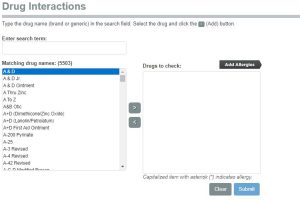
- Published by IBM/Watson Health
- Available online via HSL (must be on campus to access!)
- Interaction is rated by severity level
- Contraindicated
- Major
- Moderate
- Minor
- Unknown
- Interaction is rated based on level of documentation (Excellent -> Fair)
- Includes management information and details on supporting literature
- Interaction tool allows you to search for prescription and over-the-counter medications; can also add drug allergies into the search
- Automatically performs interaction check for drug-drug, drug-pregnancy, and drug-lactation interactions
- Select drugs may include interactions for the following:
- Drug-Ethanol
- Drug-Lab
- Drug-Tobacco
Always double-source drug interactions in at least 2 references!
Adverse Effects
Meyler’s Side Effects of Drugs: The International Encyclopedia of Adverse Drug Reactions and Interactions
- Available as a *physical* book only via HSL
- International reference and includes non-US medications
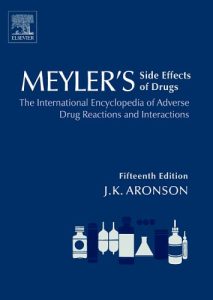
- Case reports of adverse effects
- Individual drugs and drug classes
- ADRs classified by organ system
- Organization of material in monographs is as follows:
- Drug studies (primary literature)
- Organs and systems
- Long-term effects
- Second-generation effects (eg., fertility, pregnancy, teratogenicity, fetotoxicity, milk production, breast feeding exposure)
- Susceptibility factors
- Drug administration
- Interactions
- Interference with diagnostic tests
- Diagnosis and management of adverse drug reactions
- Monitoring
- Available in 2 forms:
- 16th edition (2016) is a single book organized alphabetically by drug name
- 7 books organized by drug classes (2008-2010 editions)
- Endocrine and metabolic, cardiovascular, herbal, psychiatric, anesthesia, analgesics and anti-inflammatory, antimicrobial
“Go-to reference for detailed information about specific adverse effects of medications.
Let’s return to Dan who, as you recall, has osteoarthritis pain and would like to know if he could use Aleve® in addition to all his other medications.
What resource would you consult to answer Dan’s question? And what would be your response?
Questions
Use the scenarios provided to answer the following questions. Click Check Answer to compare your responses to the instructor’s answers.
1. Carl comes into your pharmacy and tells you that he just got out of the hospital after having developed crystal nephropathy from taking a course of levofloxacin to treat a urinary tract infection. You are not familiar with levofloxacin causing this side effect and you would like to know if any case reports have been published on the subject. Which reference(s) would you consult and why?
2. How should doxorubicin hydrochloride liposome injection (Doxil®) be diluted (ie. in which solution is it compatible)? Is it necessary to use an in-line filter?
3. Chester is a two-year-old boy who is being treated with vancomycin for a bacterial infection. He is unable to take any food or medication by mouth and is therefore receiving nutrition intravenously (ie. total parenteral nutrition or TPN). His nurse calls you wanting to know if vancomycin and TPN are Y-site compatible (able to run into the same IV line). Which would be the best reference(s) to consult for this information?